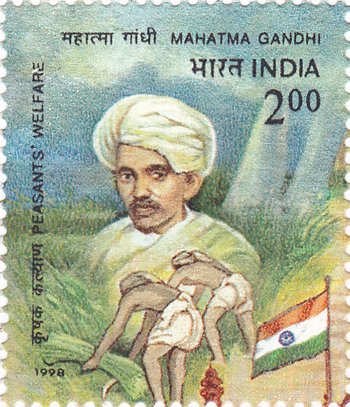Mahatma Gandhi – Peasant’s Welfare (50th Death anniversary)

Technical Data
| Stamp Set | Golden Jubliees Mahatma Gandhi Memorial |
|---|---|
| Date of Issue | January 30, 1998 |
| Denomination | Rs. 2 |
| Quantity | 700,000 |
| Perforation | comb 14 |
| Printer | Security Printing Press, Nashik |
| Watermark | No Watermark |
| Colors | Multicolor |
| Catalog Codes |
Michel IN 1611 Stamp Number IN 1671 Yvert et Tellier IN 1378 Stanley Gibbons IN 1775 |
| Themes | Anniversaries and Jubilees | Famous people | Headgear | Human Rights | Independency Activists | Lawyers-Advocates | Teachers |
Table of Contents
Commemorative Stamp Set: 50th Anniversary of Mahatma Gandhi’s Martyrdom
Design Elements:
- Central Imagery: The set includes four stamps, each representing a significant aspect of Mahatma Gandhi’s life and contributions. These include his role in the Champaran movement, the socio-economic upliftment of villages, the Salt Satyagraha, and his efforts to maintain communal harmony.
- Symbolic Representations:
- Champaran Movement: Gandhi standing with peasants, symbolizing his first major non-violent protest in India.
- Village Upliftment: An image of a rural village with spinning wheels, highlighting Gandhi’s focus on rural self-reliance.
- Salt Satyagraha: Gandhi leading the march to Dandi, representing his protest against the British salt tax.
- Communal Harmony: Gandhi walking through villages barefoot, symbolizing his efforts to prevent communal violence.
- Color Palette: Earthy tones with deep greens, blues, and browns, reflecting Gandhi’s connection to the land and the common people.
Cultural and Historical Significance:
- Gandhi’s Legacy: The stamps commemorate Gandhi’s pivotal role in India’s independence movement and his enduring impact on global peace and non-violence.
- Turning Points: Each stamp highlights a turning point in India’s struggle for freedom, from the Champaran movement to the Salt Satyagraha, and Gandhi’s efforts to bring peace during the partition.
- National Remembrance: Issued on the 50th anniversary of Gandhi’s martyrdom, these stamps serve as a reminder of his sacrifice and the values he championed.
Usage:
- Commemorative Purpose: These stamps honor Gandhi’s legacy and mark the 50th anniversary of his assassination, offering a visual tribute to his contributions.
- Educational Tool: They serve as a medium to educate the public about Gandhi’s life, the significance of non-violence, and the history of India’s freedom struggle.
- Collectible Item: The stamps are valuable for philatelists and those interested in Indian history, representing key moments in Gandhi’s life.
Importance of the Commemorative Stamp Set:
- National Homage: The set is a profound tribute to Gandhi, encapsulating his philosophy and key contributions to India’s independence.
- Promotion of Non-Violence: The stamps reinforce Gandhi’s ideals of non-violence and communal harmony, promoting them as timeless principles.
- Cultural Heritage: They are a celebration of India’s cultural and historical heritage, highlighting the country’s journey to independence under Gandhi’s leadership.
Example of the Stamp Design:
- Stamp 1: Gandhi with peasants in Champaran, symbolizing his fight for justice against oppressive indigo planters.
- Stamp 2: A rural Indian village, with a spinning wheel, symbolizing Gandhi’s vision of self-reliant villages as the backbone of India.
- Stamp 3: Gandhi leading the Salt March, representing the power of peaceful resistance against colonial oppression.
- Stamp 4: Gandhi walking barefoot through villages during the partition, symbolizing his efforts to restore communal harmony.
Significance:
- Tribute to the Mahatma: The stamp set is a heartfelt tribute to Mahatma Gandhi, commemorating his life, his struggles, and his legacy on the 50th anniversary of his martyrdom.
- Inspiration for Future Generations: It serves as an inspiration to future generations to uphold Gandhi’s principles of truth, non-violence, and justice.
- Cultural Education: The stamps also play an important role in educating people about the pivotal moments in India’s history and the values that shaped its independence.
